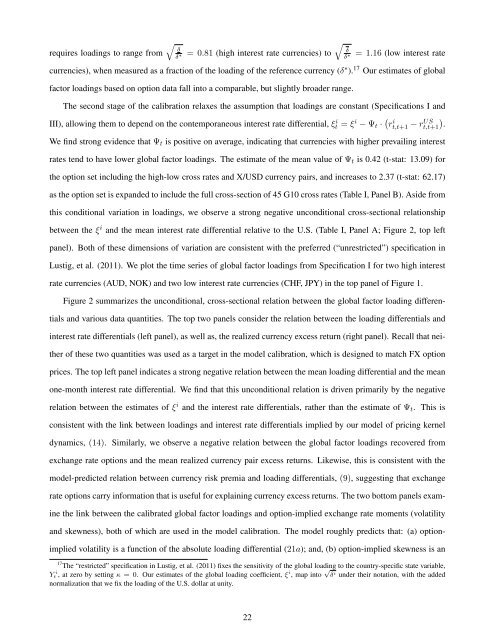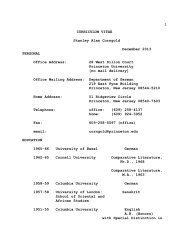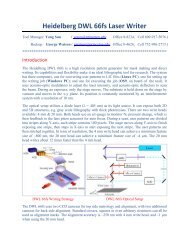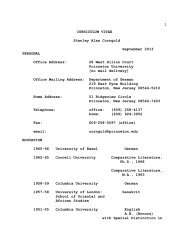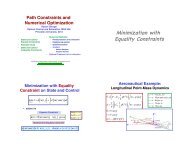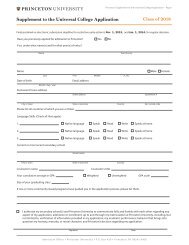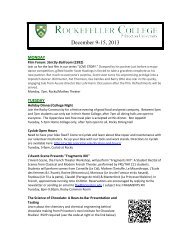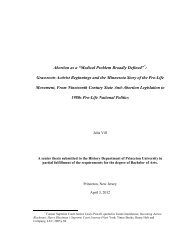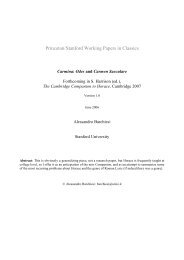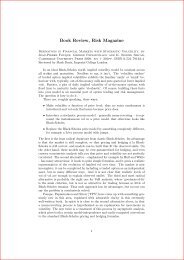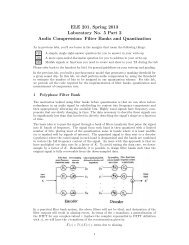Option-Implied Currency Risk Premia - Princeton University
Option-Implied Currency Risk Premia - Princeton University
Option-Implied Currency Risk Premia - Princeton University
Create successful ePaper yourself
Turn your PDF publications into a flip-book with our unique Google optimized e-Paper software.
√<br />
δ<br />
requires loadings to range from<br />
δ ∗<br />
√<br />
= 0.81 (high interest rate currencies) to<br />
δ<br />
δ ∗<br />
= 1.16 (low interest rate<br />
currencies), when measured as a fraction of the loading of the reference currency (δ ∗ ). 17 Our estimates of global<br />
factor loadings based on option data fall into a comparable, but slightly broader range.<br />
The second stage of the calibration relaxes the assumption that loadings are constant (Specifications I and<br />
III), allowing them to depend on the contemporaneous interest rate differential, ξt i = ξ i − Ψ t · (r<br />
t,t+1 i − t,t+1) rUS .<br />
We find strong evidence that Ψ t is positive on average, indicating that currencies with higher prevailing interest<br />
rates tend to have lower global factor loadings. The estimate of the mean value of Ψ t is 0.42 (t-stat: 13.09) for<br />
the option set including the high-low cross rates and X/USD currency pairs, and increases to 2.37 (t-stat: 62.17)<br />
as the option set is expanded to include the full cross-section of 45 G10 cross rates (Table I, Panel B). Aside from<br />
this conditional variation in loadings, we observe a strong negative unconditional cross-sectional relationship<br />
between the ξ i and the mean interest rate differential relative to the U.S. (Table I, Panel A; Figure 2, top left<br />
panel). Both of these dimensions of variation are consistent with the preferred (“unrestricted”) specification in<br />
Lustig, et al. (2011). We plot the time series of global factor loadings from Specification I for two high interest<br />
rate currencies (AUD, NOK) and two low interest rate currencies (CHF, JPY) in the top panel of Figure 1.<br />
Figure 2 summarizes the unconditional, cross-sectional relation between the global factor loading differentials<br />
and various data quantities. The top two panels consider the relation between the loading differentials and<br />
interest rate differentials (left panel), as well as, the realized currency excess return (right panel). Recall that neither<br />
of these two quantities was used as a target in the model calibration, which is designed to match FX option<br />
prices. The top left panel indicates a strong negative relation between the mean loading differential and the mean<br />
one-month interest rate differential. We find that this unconditional relation is driven primarily by the negative<br />
relation between the estimates of ξ i and the interest rate differentials, rather than the estimate of Ψ t . This is<br />
consistent with the link between loadings and interest rate differentials implied by our model of pricing kernel<br />
dynamics, (14). Similarly, we observe a negative relation between the global factor loadings recovered from<br />
exchange rate options and the mean realized currency pair excess returns. Likewise, this is consistent with the<br />
model-predicted relation between currency risk premia and loading differentials, (9), suggesting that exchange<br />
rate options carry information that is useful for explaining currency excess returns. The two bottom panels examine<br />
the link between the calibrated global factor loadings and option-implied exchange rate moments (volatility<br />
and skewness), both of which are used in the model calibration. The model roughly predicts that: (a) optionimplied<br />
volatility is a function of the absolute loading differential (21a); and, (b) option-implied skewness is an<br />
17 The “restricted” specification in Lustig, et al. (2011) fixes the sensitivity of the global loading to the country-specific state variable,<br />
Yt i , at zero by setting κ = 0. Our estimates of the global loading coefficient, ξ i , map into √ δ i under their notation, with the added<br />
normalization that we fix the loading of the U.S. dollar at unity.<br />
22


